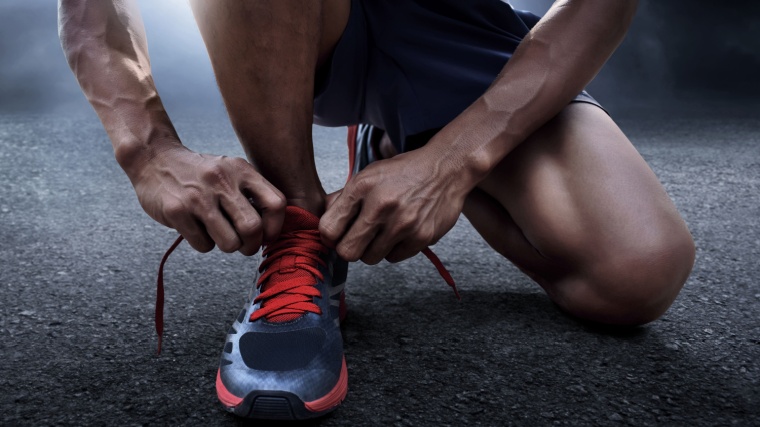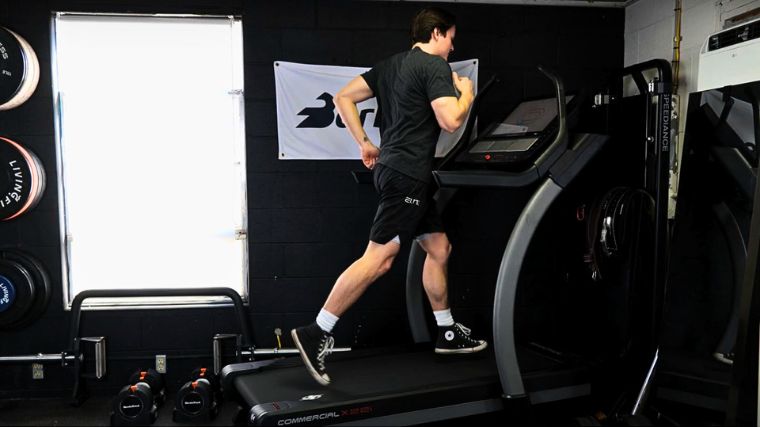[ad_1]
Key Takeaways
- The average pair of running shoes has a lifespan of 300-500 miles.
- For someone who runs 15 miles per week, they should replace their shoes every 5 to 8 months.
- Running on old shoes increases the risk of injury to muscles and joints.
- One study showed a 45% loss of initial shock absorption in running shoes after 500 miles. (1)
When you purchased your pair of Nike Pegasus kicks and loaded up your Strava app to hit the trails, you fell in love with them the instant you tightened the laces and went out for a run. They were the best running shoes you had ever owned in your life. Well, now it’s five months later, and your Pegasus appears to have lost its wings. Your shoes simply aren’t giving you the same quality performance you’ve come to expect from them.

 Credit: FOTOKITA / Shutterstock
Credit: FOTOKITA / Shutterstock
It’s not your shoes’ fault this is happening. How long do running shoes last, anyway? I’ll take you through the basics. Then, to help you extend the life of your shoes for as long as possible, I spoke with elite running coach and world-class ultra-distance runner Lee Whitaker. Let’s go.
How Many Miles Do Running Shoes Last?
Provided that your running shoes are kept in a safe, dry environment, their staying power is not about how long you own them — it’s about how much you use them. The interaction of the shoe with training surfaces like asphalt, granite, sand, dirt, or the woven polyester of a treadmill belt are what make the difference in how long your shoes last.
Most estimates of the lifespan of a pair of running shoes are communicated in terms of mileage. Heavy-duty running shoes are presumed to last anywhere from 300 to 500 miles, whereas lightweight shoes last 250 to 300 miles. In both cases, the cushioning of the shoes is gradually breaking down with each use. The weight of the runner, alongside the firmness and abrasiveness of your running surfaces, can also accelerate the wear and tear.
[Read More: How Many Miles Should I Run a Day? Insights From a CPT]
An athlete who runs 10 miles a day three times a week will probably have to replace shoes more often than someone who runs three miles a day every day of the week. However, that formula might change if the person running fewer miles is of a higher weight, if they always run on hard outdoor surfaces, and if they take harder, more aggressive strides.
How To Tell When You Need New Running Shoes
You’re likely to encounter more than one telltale sign that it’s time to replace your worn-out shoes. Most of it will be obvious when you examine your kicks up close. Yet even if you’re in denial that your favorite pair of shoes’ life is nearing its end, your body will register all sorts of hints that your shoes are no longer cutting the mustard.
The Shoe Looks Worn
If your running shoes just can’t hack it anymore, they will probably look at least a little…well, messed up. The bottom of the shoe will likely display the most obvious signs of overuse. If the outsole of your shoe looks like much of it has been worn away, head to the running store and purchase the type of shoe that can hold up to the demands of your workout.
[Read More: The Best Stability Running Shoes, Tested and Trialed by Our Team]
“Your shoes are definitely going to have visible wear,” explains Whitaker. “The bottom of the shoe will get really worn. The shape of the bottom of the shoe becomes very different. You even get some wear in the upper portion, too. It just develops a hole where a seam starts to tear. Eventually, the shoe just breaks down.”
The Shoe Doesn’t Bounce the Same
By design, your running shoes should have a bouncy element to them during your foot strike, in addition to their cushioning. Part of that bounce stems from the midsole — an internal layer of cushioning between your feet and the shoe’s outsole. As the cushioning will break down with repeated use, so will the ability of your shoes to rebound, even if you’re a midfoot or forefoot striker.
[Read More: The Best Shoes for Treadmill Running, Ran In and Tested by Our Experts]
“One of the things that we’ll feel differently about the shoe is that it will have a dead feeling to it,” states Whitaker. “It simply won’t rebound off the ground as well as it used to. I always like to compare it to a tennis racquet that has loose strings. Before, the ball would bounce nicely off the racquet, but now it just drops to the ground. When your running shoes lose their bounce, then you’re losing much of the advantage that comes from having running shoes in the first place.”
Your Legs Start to Hurt
You may be used to a certain type of muscle fatigue during your runs, but if you suddenly start to feel soreness in odd places, it might be a consequence of worn-out shoes. This is not to be taken lightly, as an absence of cushioning can be a precursor to some more troublesome running injuries. (2) The bottom line is that you don’t want the breakdown of your shoes to lead to a concurrent breakdown in your body.
[Read More: The Best Leg Exercises and Workouts for Stronger Legs]
“A lot of people will start to feel maybe just a little bit of pain, or will sense that something is just not quite right with their knees or their shins,” reflects Whitaker. “That’s because the shoe is starting to wear and it’s not supporting the runner or tracking with their gait the way that it was designed and meant to do. So you start to develop some pain in places where you never had it before. It will usually just show up overnight almost, and that may be a sign that the shoe is not working quite right.”
How To Make Running Shoes Last Longer
Even if you take good care of your shoes, their cushioning will eventually break down and force you to purchase a new pair of shoes. As a man who has burned through every type of racing shoe imaginable, Whitaker has some tremendous tips for how to preserve them.
Rotate Your Shoes
The more time you spend running in a pair of new running shoes, the more rapidly they begin to resemble old running shoes. That’s because the signs of wear on your shoes increase in number and severity with each use. To slow the speed with which symptoms of excessive wear reveal themselves, make room next to your Asics for a pair of Brooks, some New Balance, and maybe even a pair of Adidas.
[Read More: How to Break in Running Shoes: A Running Coach Explains How To Do it Properly]
“I recommend to just about anybody who’s going to run and go through shoes on a somewhat regular basis to rotate through anywhere from two to four pairs of shoes,” explains Whitaker. “Shoe rotation extends the life of any given pair of shoes. It will cost you the same amount over time, and it will certainly extend the life of any individual shoes.”
Run on a Treadmill
To a certain extent, you can make running shoes last longer if you transfer more of your running workouts over to the treadmill. The shock absorption and smooth surface can lengthen the lifespan of your favorite pair of shoes somewhat, but certainly not indefinitely. Because there are competitive advantages to road running, you’ll need to decide whether it’s worth the sacrifice just to squeeze out another few weeks of use.


[Read More: Running on a Treadmill Vs. Running Outside — Which Is Best for Your Goals?]
“Shoes would definitely wear less on a treadmill than asphalt or concrete,” says Whitaker. “A shoe would still break down over time and use, but the softer surface would save some wear on the bottom. Still, I doubt that it’s significant enough to matter to most serious runners, at least to the point where they would feel the need to plan around it.”
Frequently Asked Questions
How often should running shoes be replaced?
Heavy-duty shoes are usually replaced after they accumulate between 300 and 500 miles of wear during training. Lightweight running shoes are usually replaced after 250 to 300 miles of running activity.
How do I know when my running shoes are worn out?
Visually, your shoes will have signs of uneven wear in the areas where they most frequently strike the ground. This will vary depending on the strike point of your foot. Even without checking for wear patterns, you will notice a difference in how the shoe feels when it strikes the ground, as worn-out shoes rebound from the ground differently. You may also notice atypical pains popping up suddenly.
How many miles can a pair of running shoes last?
Running shoes typically last between 300 and 500 miles of wear during training. Lightweight running shoes usually require replacement after 250 to 300 miles of running activity.
References
- Heidenfelder, Jens & Sterzing, Thorsten & Milani, Thomas. (2009). Biomechanical wear testing of running shoes. Footwear Science. 1. 16-17.
- Ryan M, Elashi M, Newsham-West R, Taunton J. Examining injury risk and pain perception in runners using minimalist footwear. Br J Sports Med. 2014 Aug;48(16):1257-62. doi: 10.1136/bjsports-2012-092061. Epub 2013 Dec 19.
Featured Image: FOTOKITA / Shutterstock
[ad_2]
Source link
Fitnessnacks – #Long #Running #Shoes #Tips #Coach #Shoes #Longer
Courtesy : https://barbend.com/how-long-do-running-shoes-last/
